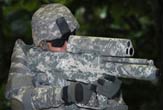
The U.S. Army will equip a group of Special Forces troops deploying to the war zone this summer with the new high-tech XM25 airburst grenade launcher that Afghanistan veterans who have fired it predict will be a game-changing weapon. If this test is successful, the Army may purchase 12,500 of the weapons.
The full name of the XM25 is “XM25 Counter Defilade Target Engagement System.” “Defilade” means a position hidden from enemy fire by a natural or artificial obstacle. That has a special resonance in Afghanistan, where a favored Taliban tactic is to take cover in buildings with thick walls, behind trees or in underground trenches, often at distances of 300 meters or more.
These kinds of targets present a challenge even for skilled marksmen with conventional small arms, since a shot is only lethal if it hits the head or vital organs. Calling in artillery or airstrikes can take anywhere from minutes to hours; by the time heavier fire power is available the enemy has often slipped away.
The XM25 will enable U.S. soldiers to target and kill these targets in just seconds by going around or over such obstacles, according to Army officials. Its 25 mm exploding “smart” rounds with embedded microchips are accurate up to 500 meters, approximately the length of five football fields. The shells have a lethal blast radius similar to a hand grenade, which eliminates the need for sniper-like accuracy. The explosion distance is set by the soldier before firing.
Early in May the Army demonstrated the XM at Aberdeen Test Center in Maryland by shooting its high-explosive rounds through the window of a simulated building.
Its “point-and-shoot” simplicity makes it easy for soldiers to learn how to use the XM25 effectively. But it’s hardly a simple weapon. Its fire control system uses an array of precision sensors, lasers and optics to measure the distance to the target. “This is the first time we’re putting a smart weapon in the hands of our soldiers at the infantry squad level,” Col Doug Tamilio said at the Aberdeen demonstration. Tamilio is project manager for soldier weapons with the Army’s Program Executive Office Soldier.
When the soldier pulls the trigger, the target data is wirelessly transmitted to the shell’s micro-chip and sets it to detonate above or behind the enemy. A switch on the trigger guard lets the soldier add or subtract one or two meters to the distance, to ensure the shell explodes inside a building or beyond a wall, for example, spreading shrapnel in a 360 degree radius. “The round knows exactly where to burst over the target,” Tamilio said.
Sign up for the Live Science daily newsletter now
Get the world’s most fascinating discoveries delivered straight to your inbox.
“It brings, right now … the capability to defeat targets that we’re seeing every day in Afghanistan — targets that we can’t currently hit,” he added. “It will save soldiers’ lives because now they can take out those targets.”
This is not fighting the enemy on the cheap. Each production XM25 will cost $25,000 and shells are $25 apiece. The weapon carries four rounds in its magazine and weighs 14 pounds. For comparison, the standard issue M4 carbine weighs 7.5 pounds loaded.
The final decision to purchase 12,500 weapons, which are made by Heckler and Koch, is pending program review by senior Army officials. Field reports and soldier comments will be incorporated in a final production version, Tamilio said.









